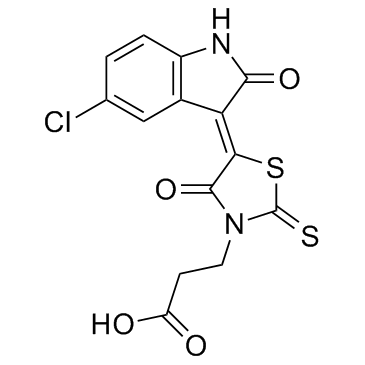All AbMole products are for research use only, cannot be used for human consumption.

In vitro: DLBCL cells are exposed to 50 μM FX1 for 30 minutes. FX1 profoundly reduces recruitment of BCOR and SMRT to all 3 BCL6 target genes, but not at a negative control locus. There is little presence of SMRT at these loci in the BCL6-negative DLBCL cell line, which is not affected by FX1. The superior potency of FX1 versus 79-6 in disrupting BCL6 binding to SMRT is evident when these small molecules are compared head to head in quantitative ChIP assays in DLBCL cells after treatment with 50 μM FX1 for 6 hours. DLBCL cells are exposed to FX1 and mRNA is collect at 4 serial time points. FX1 almost invariantly induces significant derepression of these genes as compare with vehicle in 2 independent DLBCL cell lines.
In vivo: Spleens in FX1-treating mice are macroscopically indistinguishable from vehicle controls. Total B cell abundance measured by flow cytometry is unaffected by FX1. GC B cells (GL7+FAS+B220+) are significantly depleted by exposure to FX1. Splenic architecture is examined by IHC. Staining with B220 antibody reveals normal B cell follicular structures, whereas staining for the GC B cell-specific marker peanut agglutinin shows profound loss of GCs. The half-life is estimated to be approximately 12 hours. Finally, whether FX1 can induce toxic effects in mice is assessed. No signs of toxicity, inflammation, or infection are evident from H&E-stained sections of lung, gastrointestinal tract, heart, kidney, liver, spleen, and bone marrow of the fixed organs from mice treated with FX1 compare with vehicle.
| Cell Experiment | |
|---|---|
| Cell lines | DLBCL cells |
| Preparation method | Quantitative ChIP is performed in SUDHL-6 cells exposed to FX1 (black bars) or vehicle (white bars) in DLBCL cells using antibodies for BCL6, SMRT, BCOR, or IgG control to enrich for known BCL6 binding sites in the CD69, CXCR4, and DUSP5 loci, or a negative control region. |
| Concentrations | 50 μM |
| Incubation time | 24 h |
| Animal Experiment | |
|---|---|
| Animal models | SCID mice bearing SUDHL-6 xenografts |
| Formulation | 35% PEG-300, 5% Tween-80, 65% Dextrose 5% |
| Dosages | 50 mg/kg |
| Administration | i.p. |
| Molecular Weight | 368.82 |
| Formula | C14H9ClN2O4S2 |
| CAS Number | 1426138-42-2 |
| Solubility (25°C) | 30 mg/mL in DMSO |
| Storage |
Powder -20°C 3 years ; 4°C 2 years In solvent -80°C 6 months ; -20°C 1 month |
| Related Products |
|---|
| Myoglobin (from equine skeletal muscle)
Myoglobin is a small molecular pigment protein formed by binding globin to Heme, which can be reversibly bound to oxygen to form MbO2, MbO2 is called oxymyoglobin, and Mb is called deoxymyoglobin. Myoglobin has the role of transporting and storing oxygen in muscle cells. |
| Hemoglobin (from bovine blood)
Hemoglobin is a iron-containing protein in red blood cells with oxygen binding properties. Hemoglobin is an inducer of HO-1. Hemoglobin consits of heme, which binds to oxygen. Hemoglobin also transports other gases, such as carbon dioxide, nitric oxide, hydrogen sulfide and sulfide. |
| Diethylenetriaminepentaacetic dianhydride
Diethylenetriaminepentaacetic dianhydride (DTPA anhydride) is a bifunctional chelator whose anhydride can react with amino groups in proteins (such as lysine residues) to form stable amide bonds. Diethylenetriaminepentaacetic dianhydride (DTPA anhydride) can also bind to radionuclides to synthesize radionuclide-labeled drug conjugates (RDCs). |
| 3-Phenylthiophene
3-Phenylthiophene is a biochemical material that can be used in scientific research. 3-Phenylthiophene is a conducting polymer precursor. |
| DSPE-PEG-FA
DSPE-PEG2K-FA is a PEG derivative containing folic acid. DSPE-PEG2K-FA has a targeting effect and can bind to folic acid receptors in cancer cells. DSPE-PEG2K-FA forms micelles/lipid bilayers and can be used in research on targeted drug delivery systems. |
All AbMole products are for research use only, cannot be used for human consumption or veterinary use. We do not provide products or services to individuals. Please comply with the intended use and do not use AbMole products for any other purpose.


Products are for research use only. Not for human use. We do not sell to patients.
© Copyright 2010-2024 AbMole BioScience. All Rights Reserved.
